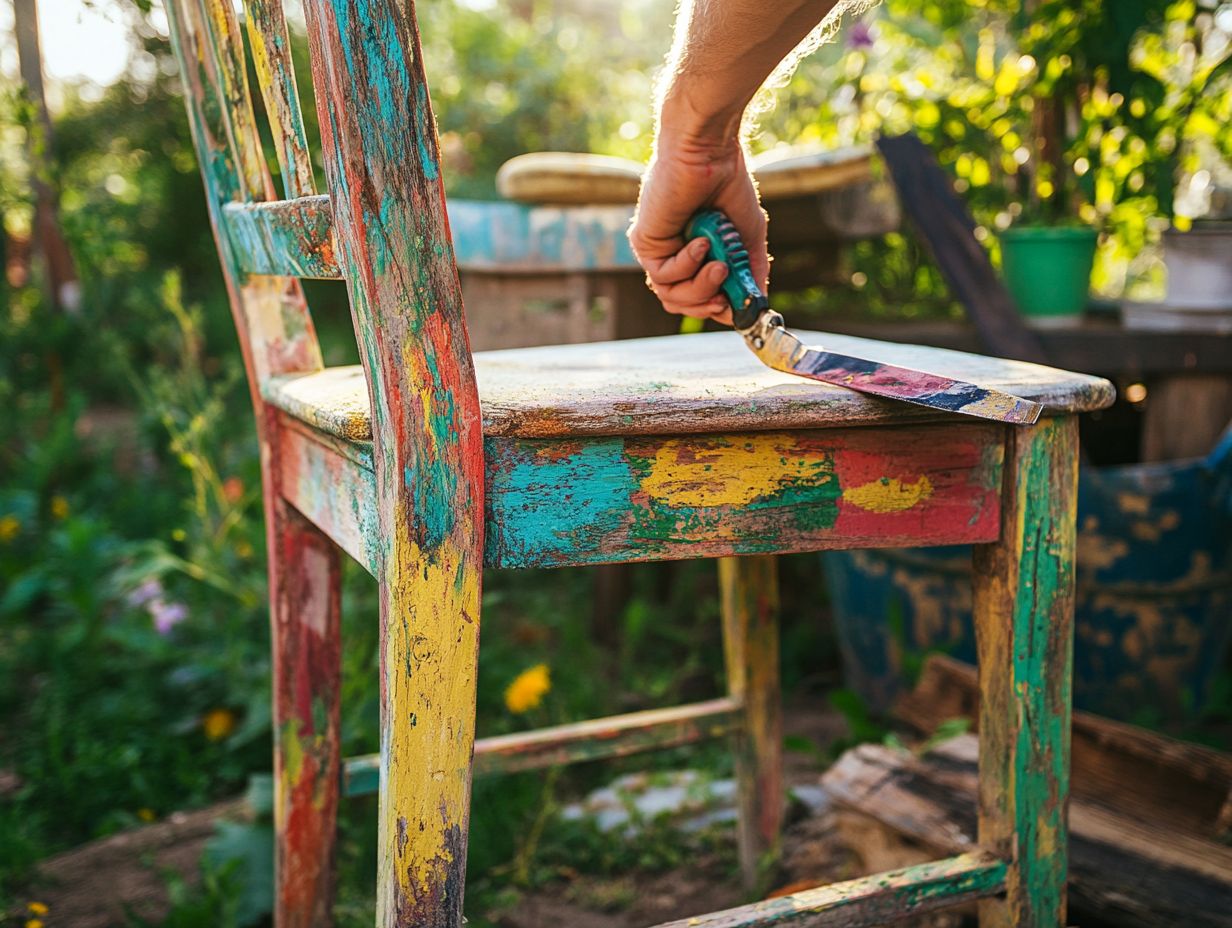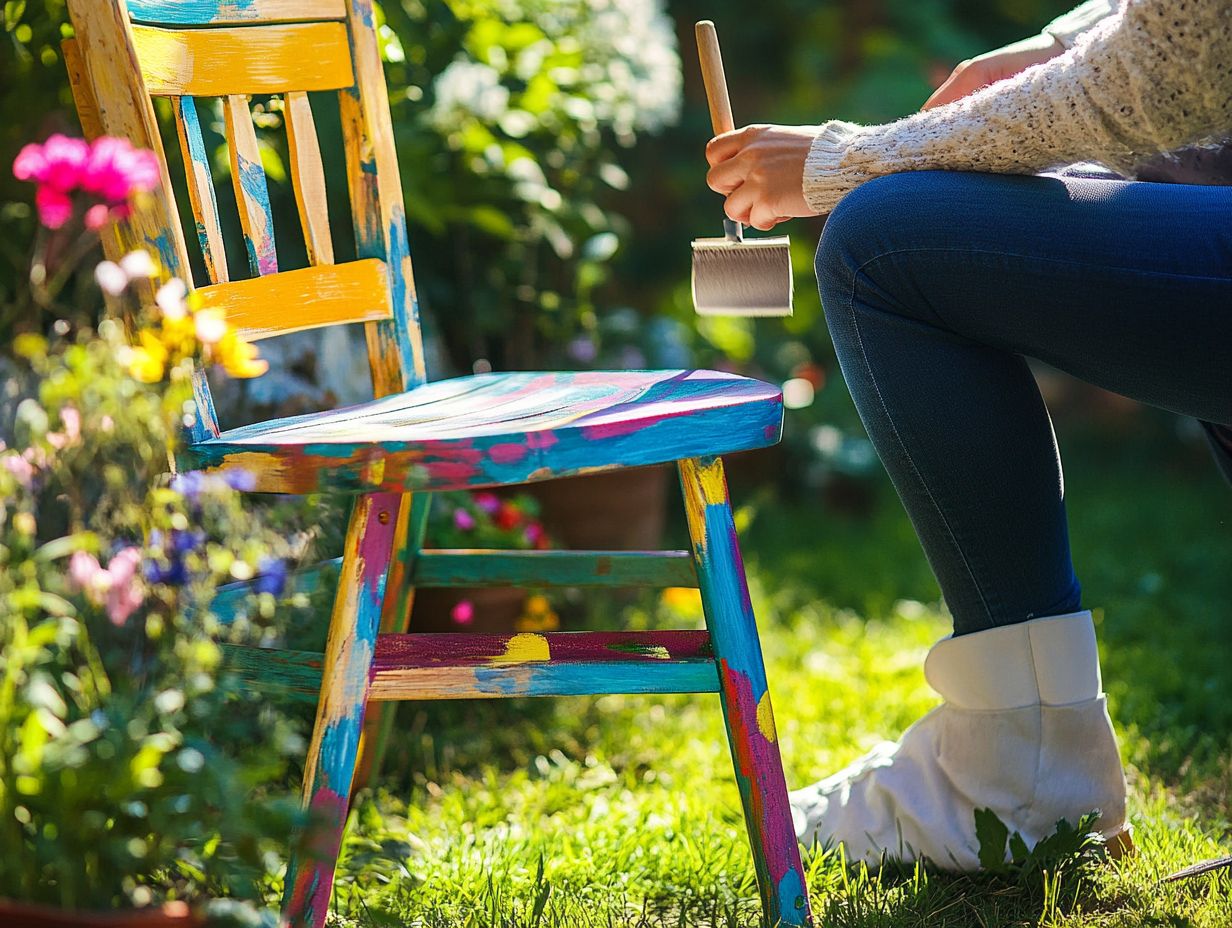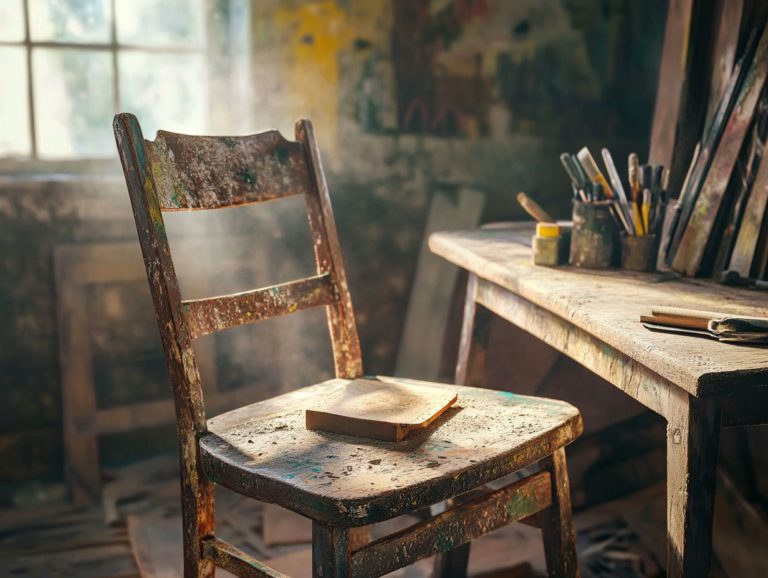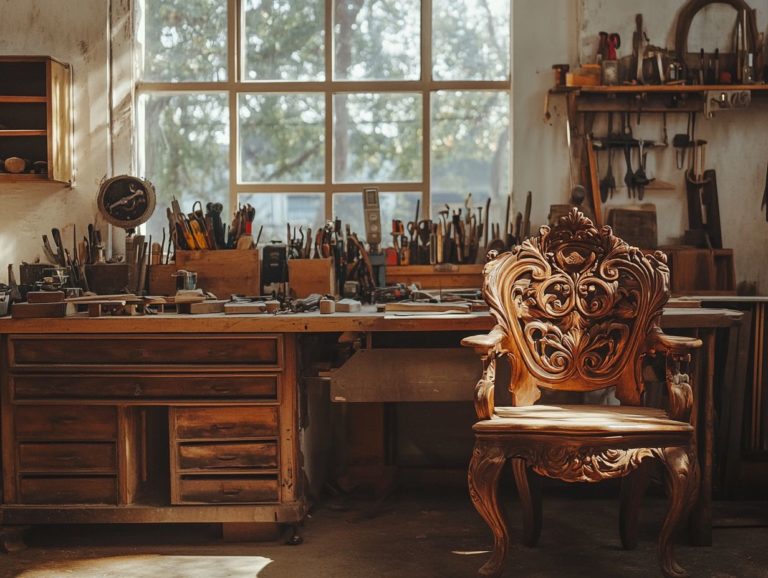DIY Restoration: Bringing Back Old Garden Furniture
Reviving your old garden furniture not only breathes new life into your outdoor space but also presents a rewarding DIY project that elevates your home’s aesthetics.
This guide will walk you through the process of restoring vintage pieces. We ll start with gathering essential materials and assessing their condition. You ll learn how to clean, repair, and finish your furniture, ensuring it can withstand the elements while dazzling your guests.
Plus, you’ll find valuable tips for long-term care. These will help your restored treasures look their best for years to come. Join us on this exciting journey of transforming your garden furniture into timeless classics!
Contents
- Key Takeaways:
- Preparing for Restoration
- Assessing the Condition of the Furniture
- Cleaning and Sanding the Furniture
- Repairing and Replacing Parts
- Staining or Painting the Furniture
- Maintaining and Protecting the Restored Furniture
- Frequently Asked Questions
- 1. How can I restore old garden furniture on my own?
- 2. What is the best way to remove rust from metal garden furniture?
- 3. Can I repair damaged wooden garden furniture?
- 4. How can I protect my restored garden furniture from the elements?
- 5. What should I do if my metal garden furniture has chipped paint?
- 6. Can I restore plastic garden furniture?
Key Takeaways:

- Save money and add a personal touch by restoring old garden furniture rather than buying new.
- Proper preparation, cleaning, and sanding are crucial for a successful restoration process.
- Regular maintenance and protective measures can extend the life of restored furniture.
Benefits of Restoring Old Garden Furniture
Restoring your old garden furniture elevates the beauty of your outdoor living space and extends the lifespan of your pieces. This promotes a sustainable approach to patio decor.
By breathing new life into weathered wood, you can craft a personalized and inviting atmosphere for family gatherings, barbecues, or serene evenings under the stars.
Refinishing wood is a cost-effective alternative to purchasing new items. It allows you to infuse character and charm into your patio while updating your decor.
Investing in restoration techniques, such as specialized cleaning solutions for wood maintenance, can dramatically enhance the longevity of your furniture and preserve its natural allure.
Incorporating outdoor cushions boosts comfort and introduces a splash of color, enriching the overall aesthetic of your patio, especially when paired with wicker furniture.
Opting for durable materials like cedar and teak ensures that your beautifully restored furniture will stand the test of time, making it a savvy and stylish addition to your outdoor space.
Preparing for Restoration
Preparing for the restoration of your outdoor furniture requires gathering essential materials and tools. These will pave the way for a successful and efficient process, from cleaning to the final finish.
Equip yourself with the right tools, like a power washer and various cleaning solutions. This can significantly lessen the time and effort spent reviving your furniture.
Understand the outdoor cushions and patio fabrics you’ll need for your decor. This will aid in planning the overall aesthetic of your outdoor space. This preparatory phase is vital to ensuring seamless restoration.
Gathering Materials and Tools
Gathering the right materials and tools is crucial for successfully restoring your outdoor furniture. This ensures every step in your DIY projects is effective and efficient.
For a stunning finish, use high-quality wood treatments like Helmsman Spar Urethane and teak oil. These can significantly enhance both durability and appearance.
Essential tools such as brushes, spray paint, sandpaper, and a spray gun are necessary for those intricate details that elevate your work.
Sourcing these materials is easy when you visit local home improvement stores or explore online retailers specializing in woodworking supplies.
Don t overlook the importance of outdoor cushions. They not only boost the comfort of your seating but also infuse a vibrant splash of color and style into your furniture, making it irresistibly inviting for gatherings.
Assessing the Condition of the Furniture
Assessing the condition of your outdoor furniture is the essential first step in figuring out how to restore it effectively. This process allows you to identify any damage and necessary repairs before you jump into the cleaning and refinishing stage.
By thoroughly inspecting your weathered wood pieces, you can uncover structural issues, signs of rot, or other wear that need your attention. This assessment guides your restoration efforts and helps you determine which materials and techniques will be most effective in rejuvenating your outdoor furniture. For specific guidance, check out this article on how to care for vintage outdoor furniture.
A careful evaluation ensures you don t miss any critical repairs, ultimately prolonging the life of your outdoor furniture and enhancing its aesthetic appeal.
Identifying Damage and Necessary Repairs

Identifying damage and necessary repairs in your outdoor furniture is essential for a successful restoration. This allows you to tackle issues before they escalate into bigger problems, especially with metal furniture that may show signs of rust.
Common types of damage you might encounter include rust on metal frames, which can weaken the furniture and lead to further deterioration if not addressed promptly. Wooden pieces often face challenges like cracks, splits, or warped surfaces due to exposure to harsh weather conditions.
When dealing with metal rust, it s wise to sand away the affected areas before applying a suitable paint that prevents rust from forming. For wooden furniture, filling cracks with wood filler or epoxy can help maintain its integrity. Applying a weather-resistant sealant provides that extra layer of protection.
Choose materials that match your furniture s style and that are made for the outdoors! This ensures your repairs last and look fantastic.
Cleaning and Sanding the Furniture
Cleaning and sanding your outdoor furniture are essential steps in the restoration process. These steps set the stage for refinishing and ensure a smooth, visually appealing finish.
Choosing the right cleaning solution is crucial; it helps you eliminate dirt, grime, and any old finishes that might have dulled the natural beauty of the weathered wood. A power washer cleans thoroughly without excessive scrubbing. It’s a quick way to restore your furniture.
Sanding refines the surface, ensuring that any paint or stain adheres properly and enhances the overall look of your outdoor furniture. When combined, these steps rejuvenate the furniture’s appearance and extend its lifespan.
Removing Dirt and Old Finish
Removing dirt and old finishes is essential for restoring outdoor furniture, setting the stage for a fresh start with refinishing, especially useful for weathered wood.
By adopting a systematic approach, you can create a clean slate that enhances the appearance of your furniture and extends its lifespan. Start by selecting an appropriate cleaning solution; this could range from eco-friendly soap and water to stronger commercial cleaners, depending on how grimy things are.
Generously apply the solution and use a scrub brush to work it into any crevices. After scrubbing, hose down the furniture thoroughly to eliminate all soap residues.
When it s time to strip old finishes, choose a solvent that aligns with your comfort and safety standards. Ensure you re in a well-ventilated area to protect your health.
Once the finish is stripped, sanding the surface will guarantee that no residual product remains. This allows for optimal adherence of new finishes, ensuring your outdoor furniture lasts longer.
Start inspecting your furniture today to discover the best restoration options!
By following these steps, your outdoor furniture will not only look great but also last for years to come!
Repairing and Replacing Parts
Repairing and replacing parts of your outdoor furniture is crucial for maintaining its strength and longevity. This is especially true for pieces that have faced the elements over time, like wicker furniture that may require special care.
By meticulously examining joints, screws, and other hardware, you can pinpoint what needs attention to restore the furniture to its former glory. This process might involve tightening loose connections or replacing rusted hardware. Both steps are essential for ensuring safety and usability in your outdoor living space.
Effective repairs ensure that your furniture not only looks stunning but also functions flawlessly for years to come. Ongoing maintenance, like regularly cleaning outdoor cushions, is key.
Fixing Structural Issues and Replacing Hardware
Fixing structural issues and replacing hardware are essential steps in restoring outdoor furniture. These actions ensure both safety and aesthetic appeal for gatherings with family and friends.
When you encounter common problems like wobbly legs, it s important to pinpoint the root cause. This could be due to uneven ground or loose joints.
A quick remedy for wobbly legs is to shim them with small pieces of wood or cardboard until your furniture sits evenly. For loose joints, tightening screws or applying wood glue offers a more lasting solution.
When replacing parts, always choose rust-resistant hardware to withstand the elements and promote longevity. Using the right screws and hinges is crucial. For instance, selecting screws that are long enough to anchor securely without splitting the wood can significantly enhance stability.
Staining or Painting the Furniture

Staining or painting your outdoor furniture is the finishing touch that elevates its visual appeal. It also adds a protective layer against the elements, ultimately extending the life of your investment. Using colors that complement your garden can enhance the overall look.
Selecting the right finish is crucial. Whether you choose a natural stain that showcases the wood’s grain or a vibrant paint color, the application process deserves equal attention.
Adequately preparing the surface and applying the product under suitable conditions ensures a smooth, professional appearance that revitalizes your patio decor. This step transforms your furniture, turning it into a captivating focal point of your outdoor environment.
Choosing and Applying a Finish
Choosing and applying a finish to your outdoor furniture is a pivotal step in the restoration journey. It influences both the aesthetics and durability of your pieces. The right choice can make a significant difference in the overall look of your patio.
A range of finishes can elevate your furniture into stunning focal points while simultaneously protecting them from harsh elements. For example, applying teak oil enhances the natural grain of the wood, giving it a rich, warm tone that offers excellent water resistance.
Alternatively, opting for spray paint options like Krylon Glitter Blast introduces a playful, decorative flair, perfect for infusing your personality into the space.
To achieve an even coat, it s wise to work in a well-ventilated area. Utilize tools such as a paint sprayer or a high-density foam roller for a smooth application. Applying several light coats instead of one heavy layer will help you attain a polished and professional look.
Don’t wait! Give your outdoor furniture the care it deserves today. Regular cleaning and upkeep keep your furniture looking its best.
Ready to get started? Let’s make your outdoor furniture shine with our step-by-step guide to restoring vintage furniture!
Maintaining and Protecting the Restored Furniture
Maintaining and protecting your restored outdoor furniture is crucial for ensuring its longevity and aesthetic appeal, especially given unpredictable weather conditions. Proper care extends beyond occasional cleaning; it requires consistent attention to details, such as the upkeep of outdoor cushions and routine checks on your storage bench for any signs of wear.
Using protective covers during bad weather safeguards your furniture s finish and structure, allowing you to enjoy your outdoor living space for years to come. By establishing a maintenance routine, you can significantly enhance the durability and visual charm of your patio decor.
Tips for Long-Term Care and Preservation
Implementing effective strategies for the long-term care and preservation of your outdoor furniture is essential for maintaining its beauty and functionality over time. For instance, a mild cleaner mixed with warm water effectively removes dirt without causing harm.
Integrating seasonal cleaning routines, applying appropriate protective coatings, and ensuring proper storage during extreme weather can significantly extend the lifespan of these cherished pieces. Investing in UV-protective coatings is wise, as it prevents fading and cracking, particularly under harsh sunlight.
Don’t forget to store your furniture properly to keep it safe and sound! Whether using covers or moving items indoors, shielding them from moisture and snow is a smart move. Regular inspections will allow you to catch any minor issues before they spiral out of control, ensuring your investment remains in excellent condition for years to come.
Frequently Asked Questions
1. How can I restore old garden furniture on my own?

To restore old garden furniture on your own, gather necessary supplies like sandpaper, paint or stain, and a sealant. Using a cleaning solution will help remove grime before you start. Thoroughly clean and sand down the furniture before applying a fresh coat of paint or stain. Finish with a sealant for added protection.
2. What is the best way to remove rust from metal garden furniture?
To remove rust from metal garden furniture, use sandpaper and a rust remover solution. A power washer can speed up the process, while a wire brush or steel wool can help scrub off the rust. Always wear protective gloves and eyewear when using chemicals.
3. Can I repair damaged wooden garden furniture?
Yes, you can repair damaged wooden garden furniture. Fill cracks or holes with wood filler and sand it down after it dries. Replace broken pieces or reinforce weak joints with wood glue, then finish with paint or stain.
4. How can I protect my restored garden furniture from the elements?
To protect your restored garden furniture, apply a sealant or outdoor varnish. This prevents water damage and fading. Store your furniture indoors during harsh weather, and consider covering outdoor pieces for extra protection.
5. What should I do if my metal garden furniture has chipped paint?
If your metal garden furniture has chipped paint, remove the old paint with sandpaper or a paint stripper. Apply a new coat of paint in a well-ventilated area and let it dry completely before using your furniture again.
6. Can I restore plastic garden furniture?
Yes, restore plastic garden furniture by cleaning it with water and mild soap. Use a plastic-friendly primer and paint for a fresh look, and consider a plastic sealant to protect against UV rays and fading.






